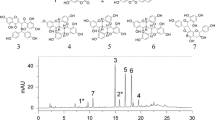Abstract
Previous experiments showed that legumes grown in the presence of living or herbicidally treated quackgrass residues or extracts exhibited reduced seedling root and shoot growth and decreased nodulation and nitrogen fixation. Aqueous extracts of quackgrass shoots were most inhibitory to plant growth. Upon sequential partitioning of an aqueous extract of quackgrass shoots, the ether extract possessed the most activity and caused 50% reductions in radicle elongation of eight crop and weed species at concentrations of less than 240 μg/ml (small-seeded species) and 1000 μg/ml (large-seeded species). Snapbeans (Phaseolus vulgaris L. “Bush Blue Lake”) grown aseptically in agar containing an ether extract at 100 and 200 μg/ml exhibited severe root browning, lack of root hair formation, and a two- to three-fold reduction in root and shoot dry weights. The ether extract of quackgrass shoots had no inhibitory effect on the growth of fourRhizobium species in Petri dishes or two species in broth culture. Inhibitors present in the ether extract may influence the legumeRhizobium symbiosis indirectly by reducing legume root growth and root hair formation. The ether extract of quackgrass shoots was separated using high-pressure liquid, thin-layer, and liquid column chromatography in an attempt to isolate and identify the inhibitors responsible for the inhibition of seedling growth. Two closely related flavonoid inhibitors were isolated from the ether extract. One was identified as 5,7,4′-trihydroxy-3′,5′-dimethoxyflavone (tricin). Both flavonoids caused 50% inhibition of radicle elongation in cress (Lepidium sativum L. “Burpee curly”) seeds at concentrations of less than 125 μg/ml. Both flavonoids were found in ether extracts of quackgrass shoots and rhizomes, but the largest amounts of both compounds occurred in quackgrass shoots collected from the field.
Similar content being viewed by others
References
Dazzo, F.B. 1982. Leguminous root nodules, pp. 431–446,in R.G. Burns and J. L. Slater (eds.). Experimental Microbial Ecology. Blackwell Scientific, Oxford, U.K.
Gabor, W.E., andVeatch, C. 1981. Isolation of a phytotoxin from quackgrass (Agropyron repens) rhizomes.Weed Sci. 29:155–159.
Harborne, J.B. 1965. Flavonoid Pigments, pp. 618–640.in J. Bonner and J.E. Varner (eds.). Plant Biochemistry, Academic Press, New York.
Holm, L.G., Pluckett, D.L., Pancho, J.V., andHerberger, J.P. 1977.Agropyron repens (L.) Beauv., pp. 153–168.in The World's Worst Weeds, Distribution and Biology, University Press, Hawaii, Honolulu.
Kommedahl, T., Old, K.M., Ohman, J.H., andRyan, E.W. 1970. Quackgrass and nitrogen effects on succeeding crops in the field.Weed Sci. 18:29–32.
LeFevre, C.W., andClaoett, C.O. 1960. Concentration of a growth inhibitor fromAgropyron repens (quackgrass).Proc. North Cent. Weed Contr. Conf. 14:353–356.
Lynch, J.M., andPenn, D.J. 1980. Damage to cereals caused by decaying weed residues.J. Sci. Food Agric. 31:321–324.
McClure, J.W. 1977. An ecological role for plant phenolics, pp. 42–62.in Report of the Research Planning Conference on the Role of Secondary Compounds in Plant Interactions (Allelopathy). Mississippi State University, Mississippi State, MS.
Ohman, J.H., andKommedahl, T. 1964. Plant extracts, residues, and soil minerals in relation to competition of quackgrass with oats and alfalfa.Weeds 12:222–231.
Oswald, H. 1948. Toxic exudates from the roots ofAgropyron repens.J. Ecol. 38:192–193.
Patrick, Z.A., Toussoun, T.A., andSnyder, W.C. 1963. Phytotoxic substances in arable soils, associated with decomposition of plant residues.Phytopathology 53:152–161.
Penn, D.J., andLynch, J.M. 1982. The effect of bacterial fermentation of couchgrass rhizomes andFusarium culmorum on the growth of barley seedlings.Plant Pathol. 31:39–43.
Phlak, F. 1967. The effect of quackgrass on succeeding plants.Plant Soil 27:273–384.
Pomilio, A.B., andRofi, R.D. 1985. 5,7,3′-Trihydroxy-4′,5′-dimethoxyflavone and other phenolics fromPoa huecu.Phytochemistry 24:2131–2132.
Rice, E.L. 1984. Manipulated Ecosystems: Roles of Allelopathy in Agriculture, pp. 1–422,in Allelopathy. Academic Press, New York.
Robinson, T. 1980. Pages 191–225,in The Organic Constituents of Higher Plants. Flavonoids and Related Compounds. Cordus Press, North Amherst, Massachussetts.
Toai, T.V., andLinscott, D.L. 1979. Phytotoxic effects of decaying quackgrass residues.Weed Sci. 27:595–598.
Voiron, B. 1983. UV spectral differentation of 5-hydroxy- and 5-hydroxy-3-methoxyflavones with mono-(4′;)-, di-(3′,4′) or tri-(3′,4′,5′)-substituted B rings.Phytochemistry 22(10):2107–2145.
Welbank, P.J. 1960. Toxin production fromAgropyron repens, pp. 158–164,in J.L. Harper (ed.). The Biology of Weeds. Blackwell Scientific Publications, Oxford, England.
Welbank, P.J. 1963. Toxin production during decay ofAgropyron repens (couchgrass) and other species.Weed Res. 3:205–214.
Weston, L.A., andPutnam, A.R. 1985. Inhibition of growth, noduiation, and nitrogen fixation of legumes by quackgrsss (Agropyron repens).Crop Sci. 25:561–565.
Weston, L.A., andPutnam, A.R. 1986. Inhibition of legume seedling growth by residues and extracts of quackgrass (Agropyron repens).Weed Sci. 34:366–372.
Wheeler, T.S. 1963. Pages 479–481,in Organic Syntheses Coll., Vol. 4. John Wiley & Sons, New York.
Wyse, D.L. 1980. Vernolate for augmentation of quackgrass (Agropyron repens) control with glyphosateWeed Sci. 28:654–657.
Author information
Authors and Affiliations
Additional information
Journal article No. 11887 of the Michigan Agricultural Experiment Station.
Rights and permissions
About this article
Cite this article
Weston, L.A., Burke, B.A. & Putnam, A.R. Isolation, characterization and activity of phytotoxic compounds from quackgrass [Agropyron repens (L.)Beauv.]. J Chem Ecol 13, 403–421 (1987). https://doi.org/10.1007/BF01880089
Received:
Accepted:
Issue Date:
DOI: https://doi.org/10.1007/BF01880089




